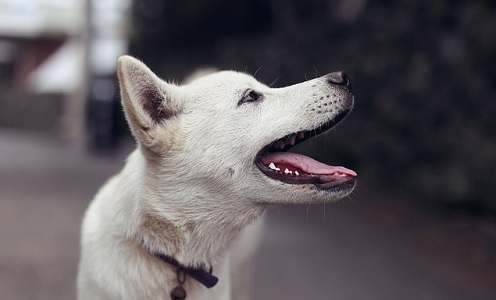For anyone who’s ever eaten a hearty meal and felt that the food didn’t “settle” well, it may have been the symptoms of acid reflux and the accompanying heartburn that goes along with it. Just as that second helping of lasagna can lead to later regret for humans, dogs may also struggle with acid reflux and its side effects, though they have fewer ways of communicating that discomfort.
A surprisingly common canine occurrence, acid reflux (the common terminology for ‘GERD’ or Gastroesophageal Reflux Disease) affects dogs of all breeds and ages, making it a persistent issue for a pet parent – not only does it have short-term, painful repercussions for your pup, but it can quietly cause long-term damage if left unchecked. In addition to being hard to notice, it can also be hard to diagnose during a normal vet visit. Therefore, a pet owner’s interactions with a beloved pooch will be his first line of defense against this troublesome, painful (but fortunately treatable) condition.
Is Acid Reflux In Dogs Contagious?
With so many known illnesses that can pass between dogs, other dogs, animals, and humans, it’s prudent to be cautious when a dog is sick, particularly in a multi-pet household. The good news is that acid reflux in dogs is not contagious – it’s limited to the dog it afflicts, and cannot be passed through licking, playing with another dog, or sharing food and water.
That said, if a pet pooch is diagnosed with acid reflux, it’s not a bad idea to examine his diet, from the occasional treat to the type of pet food brand he eats. While there are several reasons a dog can come down with reflux, diet can cause or aggravate symptoms very easily, which means another household dog could accidentally follow the same uncomfortable path.
 Additionally, while it can be a particularly unpleasant possibility to consider, the other animals in a multi-pet household may also be causing your dog’s acid reflux. If an owner observes a dog spending a little too much time near the family cat’s litterbox, for example, the pup may be ingesting certain substances that are very unhealthy for his body and digestive system. Always isolate one animal’s waste from access to another pet to prevent this issue. Likewise, if a dog shares outside space with another animal – for example, a yard, a dog park, and so on – make sure waste is picked up in a timely fashion to prevent “curiosity.” This practice will also help combat the spread of other illnesses, such as canine parasites, that will happily travel from one afflicted dog to another through waste matter.
Additionally, while it can be a particularly unpleasant possibility to consider, the other animals in a multi-pet household may also be causing your dog’s acid reflux. If an owner observes a dog spending a little too much time near the family cat’s litterbox, for example, the pup may be ingesting certain substances that are very unhealthy for his body and digestive system. Always isolate one animal’s waste from access to another pet to prevent this issue. Likewise, if a dog shares outside space with another animal – for example, a yard, a dog park, and so on – make sure waste is picked up in a timely fashion to prevent “curiosity.” This practice will also help combat the spread of other illnesses, such as canine parasites, that will happily travel from one afflicted dog to another through waste matter.
What Causes Acid Reflux In Dogs?
In addition to naturally-occurring acid reflux that crops up from age-related causes or in reaction to other illnesses, dogs can suffer from a canine hernia – a twist in the intestines that hinders the flow of acid or food – as well as congenital (i.e., from birth) causes. Ingesting a toxin or something harmful – think of an inquisitive pup accidentally drinking toilet water with a cleanser in it – can also cause acid reflux. The toxin or irritant is ingested and opens lesions or burns on the esophagus on the way down, stomach acid churns in an attempt to digest the harmful substance, and aggravates the new lesions in the process. This leads to a cycle of the same symptoms as the dog heals, and eventually leaves him with acid reflux long after the original irritant is gone.
One of the most common causes of acid reflux is something far more common: diet. This means that pet parents have a lot of discretion in preventing the symptoms, particularly as the years pass with a four-legged friend. It sounds simple, but investing in a well-balanced, high-quality food is one of the best defenses against acid reflux for dogs.
When a mass-produced kibble with artificial flavors, colors, and additives is used as a dog’s primary feed, it can be difficult to digest and may lead to churning stomach acid – and in turn, acid reflux. Even if pet folks decide to stick to a mass-produced kibble, it’s a good idea to supplement with “clean” food like boiled chicken breast or protein-rich wet food on a regular basis. This helps to balance his diet, and is a smart move for his nutrition too. While organic and all-natural or pricey, specially-formulated dog foods may not be in the budget, there are certainly whole food alternatives pet parents can cook at home for their beloved pets to ensure his diet is well-rounded – speak with a trusted vet for additional canine nutritional recommendations.
Does My Dog Have Acid Reflux?
When a dog isn’t feeling well, it’s easy for worried fur-baby parents to vanish down the proverbial rabbit hole, mentally diagnosing them with dire, painful, and expensive ailments. The first step to healing acid reflux is to determine whether common symptoms have cropped up, and to take note of how often they occur. These include behaviors such as:
- Whining or whimpering when eating, particularly when swallowing: If the dog in question doesn’t have obvious mouth sores or tooth decay issues, discomfort while swallowing signals a need for investigation. For concerned owners who are unsure and want to further test the theory, offer the dog wet or soft food and watch his behavior – if he’s not as vocal, that’s a strong indicator it may be acid reflux.
 Why this happens: Acid reflux, even in minor cases, essentially opens lesions on the soft, vulnerable skin of the esophagus in dogs. When he eats, even if his food is well-chewed, this material is passing over these lesions and causing pain and discomfort with every bite. In addition to the rough texture of chewed kibble, acidic gravies can also cause problems, so make sure the “wet food test” is done with relatively neutral, bland canine food if possible.
Why this happens: Acid reflux, even in minor cases, essentially opens lesions on the soft, vulnerable skin of the esophagus in dogs. When he eats, even if his food is well-chewed, this material is passing over these lesions and causing pain and discomfort with every bite. In addition to the rough texture of chewed kibble, acidic gravies can also cause problems, so make sure the “wet food test” is done with relatively neutral, bland canine food if possible.
- Lack of appetite or not finishing food completely: A loss of appetite in dogs is a less-precise flag over vocal discomfort, but it’s still very telling. Dogs stop eating for a variety of reasons, particularly if they’re ill, but acid reflux is definitely on the list. If a dog eats less but still seems interested in his food (and even reluctant to leave it), this behavior could indicate he’s simply suffering from a stomach acid-burned esophagus.
Why this happens: Put simply – if a person’ throat hurt every time they ate, they would probably be reluctant to chow down, too. When a dog display the aforementioned behavior, he’s balancing his absolute minimum nutritional needs against his desire to avoid pain, and that may manifest as skipping meals or eating far less than he normally does.
- Vomiting or unproductive “dry-heaving”: Dogs vomit more readily than their human counterparts, but excessive vomiting, particularly routinely after eating, is a cause for concern. This is even more true if the stomach upset appears to be a new symptom, and he previously kept his food in his stomach without issue.
Why this happens: The stomach and the esophagus are separated in both dogs and humans by a sphincter muscle, an important part of the digestive system. When acid reflux weakens this pass-through, it affects its ability to keep stomach acid where it’s supposed to be, and some flows into the esophagus. Naturally, the dog’s body recognizes this isn’t ideal. His dog coughing and gagging are a reflexive attempt to clear the acid away from sensitive throat tissues, a problem that’s particularly aggressive after meals.
Did You Know…
Vomiting can signal a “which came first” chicken-egg conundrum. While vomiting is a sign of existing acid reflux in a dog, it can also be a cause. If the dog in question is vomiting for other reasons – such as excitement, canine anxiety, illness, or even dog allergies – he could potentially become afflicted with acid reflux. This occurs due to the constant inverted stomach acid weakening his esophageal sphincter.
- Consistent bad breath: Most dogs’ favorite toys may not exactly be “April fresh”, but if they continually have bad breath, it’s something worth investigating by his humans. If he doesn’t have any visible tooth decay and hasn’t eaten anything pungent recently, the culprit might actually be stomach acid. This is even more likely if the family pooch seems to be reflexively yawning or stretching his jaw, even when he shouldn’t be tired – it’s his way of trying to alleviate the discomfort in his mouth. Keep an eye out for bad breath in dogs if you think your furry friend is suffering from acid reflux.
Why this happens: Again, stomach acid belongs in the stomach – which means that the mouth, teeth, and tongue aren’t equipped to deal with its constant presence. Stomach acid not only wears away the protective enamel of a dog’s teeth, it can also kill the beneficial bacteria that keep his mouth as close to PH-balanced as possible. Think of it like a dog living with morning breath and no toothbrush in sight – while his bad breath may be unpleasant for his owner, he probably hates it even more.
How Do I Treat Acid Reflux In My Dog?
One of the first steps to curing or mitigating canine acid reflux is to get a definitive diagnosis. Dogs aren’t always forthcoming with symptoms when they’re ill, and that means what may appear to be a simple case of acid reflux could be hiding/indicating something more substantial. That’s why it’s essential for pet parents to keep track of a pet’s symptoms – when the dog is coughing or gagging, when a decrease in appetite was observed, and so on – and to call his veterinarian. Based on the severity, the vet’s office should be able to either offer advice or schedule him for a more thorough exam. While acid reflux is relatively common in dogs and quite treatable, it’s always best to be sure it’s actually present before starting treatment. Below, some helpful tips to treat canine acid reflux:
- Avoid foods that aggravate acid reflux: It’s only natural to want to give a dog a special treat if he’s not feeling well, especially if he’s adept at giving the “puppy eyes.” Bear in mind, however, that a dog is relying upon his pet parents to do what’s best for him, and that means keeping fatty, spicy, or acidic foods out of his bowl.
 It might feel wrong to put table scraps in the trash instead of his dinner for folks used to sharing meals, but those greasy meat leftovers or those tomato-sauce-covered pieces of pasta can kick his acid issue into overdrive. In the case for especially stubborn pups, owners also need to make sure that he can’t get into the garbage – or beg for treats from an indulgent family member or guest. For fur-baby moms and dads who feel bad or want to give in, just remember: it must be done for his health and comfort, and he doesn’t know any better.
It might feel wrong to put table scraps in the trash instead of his dinner for folks used to sharing meals, but those greasy meat leftovers or those tomato-sauce-covered pieces of pasta can kick his acid issue into overdrive. In the case for especially stubborn pups, owners also need to make sure that he can’t get into the garbage – or beg for treats from an indulgent family member or guest. For fur-baby moms and dads who feel bad or want to give in, just remember: it must be done for his health and comfort, and he doesn’t know any better.
- Keep roughhousing to a minimum as he heals: With a weakened esophageal sphincter, too much movement can cause stomach acid to slosh around, leading to pain and nausea in pups afflicted with GERD. Instead, engage in more sedentary, soothing activities, such as inviting him up on the couch to catch a few episodes of a favorite show (along with a few belly rubs), or take a leisurely walk with him around the neighborhood. If he tends to “play rough” with another household pet, it might be prudent to crate or isolate one while spending time with the other, and vice-versa.
- Supplement or replace kibble with vet-approved, soft alternatives: Whether it’s a nutritious, protein-heavy canned wet food or a meal of boiled chicken and broccoli on doctor’s orders, soft food is the way to go. Without the added pain of chewing and swallowing hard, scratchy chunks of kibble, his esophagus will be able to heal faster, and he won’t feel like wincing with every bite. Certain “raw” style foods (typically found in the refrigerated case at the local pet store) may be appropriate for pet owners hesitant about cooking up homemade food for their pup.
- In severe cases, medication might be necessary: While medication is generally reserved for particularly bad cases of canine acid reflux, it’s important for owners to listen to the vet’s office if it is recommended for the affected pooch. Pro-kinetic medications aid digestion and give a dog’s esophagus a better chance to heal while keeping stomach acid where it belongs. Administer the prescribed pill or liquid at the same time every day to avoid forgetting a dose, and keep track of how well it seems to be working in order to report progress back to his vet’s office.
Summary: Recognizing & Treating The Signs Of Canine GERD
Coughing, gagging, vomiting, and whimpering aren’t just symptoms of an acid reflux issue in the family dog – they’re his way of telling his owners he’s miserable. Pet parents can help soothe a suffering dog with timely advice from his vet, along with an acid-fighting diet and a positive attitude. Oh, and a few extra scratches under the chin, while they might not heal acid reflux, certainly couldn’t hurt the healing process.
Sources:
- “Acid Reflux in Dogs.” PetMD.com, (no publish date), https://www.petmd.com/dog/conditions/digestive/c_multi_gastroesophageal_reflux. Accessed June 23, 2019.
- “Can Dogs Get Acid Reflux?” Wag Walking.com, (no publish date), https://wagwalking.com/wellness/can-dogs-get-acid-reflux. Accessed June 23, 2019.
- Becker, Dr. Karen. “Does Your Pet Lick and Cough Incessantly? It Could Mean Gastroesophageal Reflux Disease (GERD).” Healthy Pets.Mercola.com, December 28, 2014, https://healthypets.mercola.com/sites/healthypets/archive/2014/12/28/gastroesophageal-reflux-disease.aspx. Accessed June 23, 2019.
- Clark, Mike. “Acid Reflux In Dogs: Symptoms, Causes, And Treatments.” Dogtime.com, (no publish date), https://dogtime.com/dog-health/52893-acid-reflux-dogs-symptoms-causes-treatments. Accessed June 23, 2019.
- Kanaka, Rocky. “Acid Reflux in Dogs: Diet Dos and Don’ts.” The Dog Bakery.com, April 6, 2017, https://www.thedogbakery.com/blogs/news/acid-reflux-in-dogs-diet-dos-and-donts. Accessed June 23, 2019.




